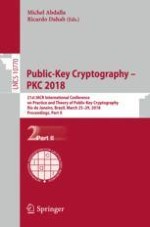2018 | OriginalPaper | Buchkapitel
Privately Constraining and Programming PRFs, the LWE Way
verfasst von : Chris Peikert, Sina Shiehian
Erschienen in: Public-Key Cryptography – PKC 2018
Aktivieren Sie unsere intelligente Suche, um passende Fachinhalte oder Patente zu finden.
Wählen Sie Textabschnitte aus um mit Künstlicher Intelligenz passenden Patente zu finden. powered by
Markieren Sie Textabschnitte, um KI-gestützt weitere passende Inhalte zu finden. powered by
